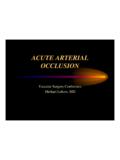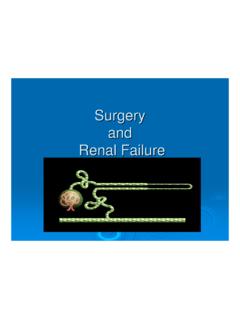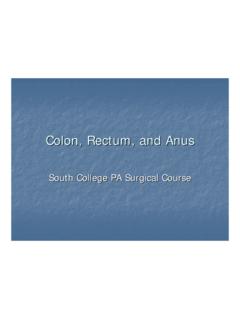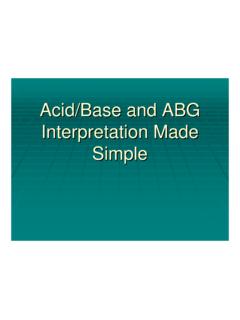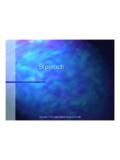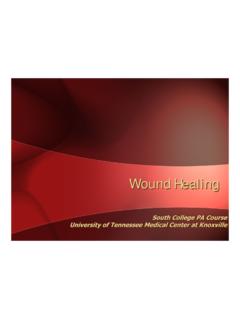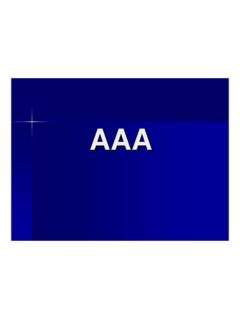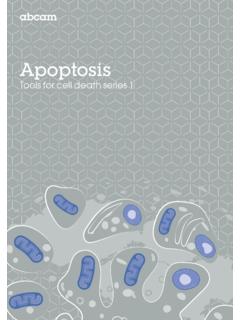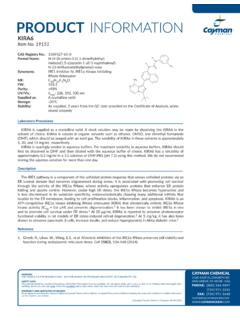Transcription of Preoperative Medical Care of the Surgical Patient
1 UTMCKP reoperative Medical care Preoperative Medical care of the Surgical Patientof the Surgical PatientByron Turkett, PAByron Turkett, PA--C, MPASC, MPASC hief PA, Division of Trauma/Critical CareChief PA, Division of Trauma/Critical CareUniversity of Tennessee Medical Center University of Tennessee Medical Center --KnoxvilleKnoxvilleUTMCKI ntroductionIntroduction A chance to cut is a chance to cureA chance to cut is a chance to cure Nothing heals like cold, hard steelNothing heals like cold, hard steel Surgery = stress and insultsSurgery = stress and insults Physiology of surgeryPhysiology of surgery Maximize preMaximize pre--operative condition of patientoperative condition of Patient Preoperative evaluation: H&PPreoperative evaluation: H&P Perioperative care : think of what can kill care : think of what can kill Medical care :Perioperative Medical care .
2 Surgical emergencySurgical emergency Cardiac diseaseCardiac disease Pulmonary diseasePulmonary disease Renal dysfunctionRenal dysfunction Liver dysfunctionLiver dysfunction DiabeticsDiabetics Bleeding disordersBleeding disorders MalnourishedMalnourished PregnancyPregnancyUTMCKP erioperative Medical care :Perioperative Medical care : Surgical emergencySurgical emergency TraumaTrauma Cardiac diseaseCardiac disease Pulmonary diseasePulmonary disease Renal dysfunctionRenal dysfunction Liver dysfunctionLiver dysfunction DiabeticsDiabetics Bleeding disordersBleeding disorders MalnourishedMalnourished PregnancyPregnancyUTMCKS urgical EmergencySurgical Emergency 76 yo WM 76 yo WM codedcoded in front of HLVI in front of HLVI building; ACLS followed x 20 min with building; ACLS followed x 20 min with intermittent pulse return.
3 Intubated, IVs intermittent pulse return; intubated, IVs placed, brought to ER; SBP 60 with HR placed, brought to ER; SBP 60 with HR returnreturn MICU team called to eval; pt started on MICU team called to eval; pt started on NeoNeo--synephrine for bpsynephrine for bp Surgery called when Hct returned called when Hct returned EmergencySurgical Emergency What do you want to do? HISTORY & PHYSICAL History? (tailor to situation) VS 70/20 135 16 (IMV) Pt is unconscious, intubated, not moving-abdomen is verydistended, quiet BS Keep DDx in mind during H&P Why can t he keep a bp?
4 What do you want to do about it? Risk of doing somethingvs. risk of doing nothing? What do you need to do before surgery?UTMCKS urgical EmergencySurgical Emergency AMPLE historyAMPLE history AA MM PP LL EEllergiesedicationsast Medical historyast mealvents preceding the surgeryUTMCKUTMCKUTMCK44 yo WF who presented to ER 44 yo WF who presented to ER today with RUQ three days today with RUQ three days ago. RUQ U/S showed ago. RUQ U/S showed gallstones. CT scan of the gallstones. CT scan of the abdomen/pelvis showed abdomen/pelvis showed PrePre--op this patientop this Patient History and physicalHistory and physical Informed consent for operation and bloodInformed consent for operation and blood Type and screen or type and crossType and screen or type and cross CXR (age greater than 20)CXR (age greater than 20) 1212--lead ECG (age greater than 40)lead ECG (age greater than 40) BMP, M/P, CBC, PT, PTT, INRBMP, M/P, CBC, PT, PTT, INR NPO after MN (IV Fluids)
5 NPO after MN (IV Fluids) PrePre--op Noteop Note PrePre--op Orders (hep 5000 units SQ, op Orders (hep 5000 units SQ, AbxAbx, beta , beta blocker)blocker) ?Bowel Prep?Bowel PrepUTMCKPrePre--Op Labs and StudiesOp Labs and Studies CBC CBC AnemiaAnemia MalignancyMalignancy Renal DiseaseRenal Disease Cardiac DiseaseCardiac Disease PregnancyPregnancyUTMCKPrePre--Op Labs and StudiesOp Labs and Studies ChemistryChemistry DiabetesDiabetes HTNHTN CVDCVD Renal DiseaseRenal Disease Liver DiseaseLiver Disease Diuretic UseDiuretic Use ElderlyElderlyUTMCKPrePre--Op Labs and StudiesOp Labs and Studies UAUA Rarely Needed, only if symptomaticRarely Needed.
6 Only if symptomatic CXRCXR Rarely indicated as screening toolRarely indicated as screening tool EKGEKG Males >40, Females >50 ?baselineMales >40, Females >50 ?baseline History of CVD, DM. HTNH istory of CVD, DM. HTN Planned thoracic, aortic, Planned thoracic, aortic, intraperitonealintraperitonealor emergency or emergency surgerysurgeryUTMCKS ymptomatic Cardiac Disease Symptomatic Cardiac Disease Work UpWork Up History of eventHistory of event Physical examPhysical exam 1212--Lead ECGLead ECG CXRCXR ABGABG Cardiac PanelCardiac Panel BMP, M/P, CBC, PT, PTT, INRBMP, M/P, CBC, PT, PTT.
7 INR Chart ReviewChart ReviewUTMCKF inding Cardiac Disease in the Finding Cardiac Disease in the Asymptomatic PatientAsymptomatic Patient Abnormal vital signsAbnormal vital signs Assess functional statusAssess functional status TachycardiaTachycardia JVD at 30 degreesJVD at 30 degrees BruitsBruits Pedal EdemaPedal Edema Rubs and 3 Rubs and 3rdrdheart soundsheart sounds MurmursMurmurs Most apical systolic murmurs are innocentMost apical systolic murmurs are innocent Any murmur with a thrill or any diastolic are NOT Any murmur with a thrill or any diastolic are NOT innocentinnocentUTMCKC ardiac disease in periCardiac disease in peri--op periodop periodMIMI arrhythmiasarrhythmiasCHFCHF CAD can cause any of theseCAD can cause any of these Risks for CAD:Risks for CAD: age, sex, HTN, XOL, DM, tobaccoage, sex, HTN, XOL, DM, tobacco Modify those risk factors you those risk factors you therapywill cover later.
8 UTMCKC oronary Artery DiseaseCoronary Artery Disease Definition of of Physiology of surgeryPhysiology of surgery:: myocardial oxygen demandmyocardial oxygen demand catecholamines: catecholamines: HR, HR, contractility, contractility, PVRPVR HR also causes decreased diastolic fillingHR also causes decreased diastolic filling Coronary arteries fill in diastoleCoronary arteries fill in diastole Less blood flowing in coronaries: less myocardial OLess blood flowing in coronaries: less myocardial O22supplysupplyUTMCKM yocardial InfarctionMyocardial Infarction Pt without risks has chance of MIPt without risks has chance of MI Pt with risks has 5% chance of perioperative MIPt with risks has 5% chance of perioperative MI Perioperative MI has 17 Perioperative MI has 17--41% mortality41% mortality CAD causes causes at PMHlook at PMH Risk stratifications:Risk stratifications.
9 MI w/in 3 months of ORMI w/in 3 months of OR27% reinfarction rate27% reinfarction rateMI 3MI 3--6 months before OR6 months before OR10% reinfarction rate10% reinfarction rateMI >6 months of ORMI >6 months of OR55--8% reinfarction rate*8% reinfarction rate*UTMCKP revention of perioperative Prevention of perioperative cardiac eventscardiac events1)1)Wait 6 months if possibleWait 6 months if possible2)2)BetaBeta--blockade*blockade* 200 pts with CAD or risk factors for CAD200 pts with CAD or risk factors for CAD atenolol preatenolol pre--op and periop and peri--op in op in MI reduced 50% in first 48hMI reduced 50% in first 48h 2 year mortality 10% vs 21%2 year mortality 10% vs 21%3)3)Maintain periMaintain peri--operative normothermiaoperative normothermia cardiac events, esp.
10 Arrhythmiascardiac events, esp. arrhythmias4)4)Treat periTreat peri--operative hypertensionoperative hypertension* Mangano NEJM335:1713, of perioperative Prevention of perioperative cardiac eventscardiac events7)7)Watch for and treat arrhythmiasWatch for and treat arrhythmiasCauses?Treatment?Drugs, electrolytes, ischemia, fluid shifts, body Tunderlying cause, rate control, conversionUTMCKP erioperative Medical care :Perio

